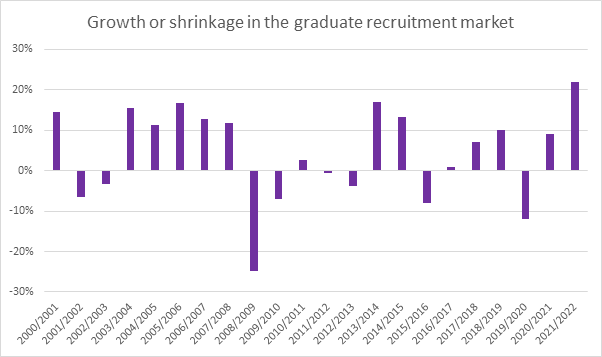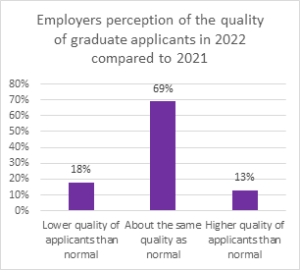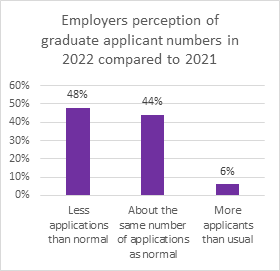ISE researcher Nicola Thomas investigates how graduate and school leaver vacancies are tracking in 2022.
Each year we ask employers how many graduates they expect to hire in the coming year and how many they hired last year. It is essential to understand how Covid-19 has impacted graduate vacancies, as the number of vacancies in 2020 and 2021 were lower following the Covid-19 pandemic.
We asked 177 employers over September to January 2022 about their graduate vacancies. We compared the results from 87 of these employers who told us about the number of their graduate vacancies in 2019 (before the pandemic), in 2021 and 2022.
In this year’s ISE Vacancy Survey 2022 we found that for the first time since pre-pandemic times, graduate vacancies are set to increase by 20% compared to 2019.

The number of graduate jobs has slowly increased since the pandemic hit, but this is the first year we have seen hiring back to pre-pandemic levels. This highlights that business confidence has improved in 2022, and emphasises the degree to which employers value a degree in the their employees.
Recovery varies across industries
Graduate vacancies in 2022 are set to increase from 2021 by more than 22%. However, this increase differs across sectors.
The biggest increase in graduate vacancies in 2022 is set to be in the built environment sector (48% growth), the energy, engineering & industry (41% growth), and the health & pharmaceuticals sector (37% growth). The only industry to experience a reduction in graduate vacancies is the charity and public sector (11% dip).
However, when we zoom out to compare the changes across sectors from 2021 to changes across sectors from before the pandemic started, we can see a different changes between sectors.
For example, compared to 2019, vacancies for graduates in the built environment sector have risen by 67%, vacancies for graduates in the digital and IT sector have risen by 42%, and unsurprisingly, vacancies in the health and pharmaceuticals sector have risen by 24%.
The only sector that is yet to reach pre-pandemic levels is the retail and FMCG sector currently 3% below graduate hires in 2019.
Student driven market for job-seeking graduates
As graduate employers continue to connect with candidates in an online setting they are struggling to get the amount of student engagement they experienced in an in-person setting.
In addition to challenges presented in a virtual environment, an increase in graduate vacancies means that graduate recruitment is set to swing to a student-driven market. This is a shift from the record high competition for graduate jobs in 2021. This shift has proved difficult for employers, with 48% of graduate employers reporting that they are receiving fewer applicants for graduate vacancies that this time last year.


For some employers both the quantity and quality of graduate applicants have dropped. For example, one in five employers indicated that the quality of graduate applicants have dropped in 2022.
While the increase of vacancies is good news for those who are job hunting, students show be aware of the need to prioritise quality and attention to detail when applying for graduate roles.
Even with increased vacancies overall, the graduate labour market remains competitive and while students should feel confident about their prospects, they need to apply themselves rigorously to their job search and make every application count.
Register for ISE’s Vacancy Survey 2022 webinar on Friday 14 January


0 Comments